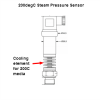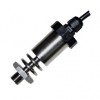Understanding the temperature limitations of a pressure transducer will help you extend the service life and prevent premature failures.
There are two main temperature ranges that should be considered before commencing a search for a pressure sensor.
First is the variation in media temperature where you will need to determine the likely minimum and maximum temperature of the process. How often the temperature extremes are reached will have a bearing on the life and accuracy of the pressure transducer.
A pressure transducer that experiences frequent temperature extremes puts more stress on the fabricated components which for many pressure transducers include industrial adhesives, brazed welds, glass to metal seals and O ring seals.
If the temperature extremes are infrequent it may not be necessary to ensure accuracy to maximum or minimum temperature since they are not typical process temperatures and therefore the pressure transducer accuracy is unlikely to be that critical at the temperature extremes.
When specifying pressure transducers you will normally find a media operating temperature range and a compensated temperature range somewhere in the technical data sheet.
 180 degC pressure sensor for saturated steam up to 10 bar
180 degC pressure sensor for saturated steam up to 10 bar Alternative 200 bar melt pressure transmitter with T/C
Alternative 200 bar melt pressure transmitter with T/C Diaphragm sealed high temperature pressure transmitter for -1 to 25 kg/cm²
Diaphragm sealed high temperature pressure transmitter for -1 to 25 kg/cm² 20 barg range 4-20mA output 300degC hi-temp air pressure sensor for aerospace testing use
20 barg range 4-20mA output 300degC hi-temp air pressure sensor for aerospace testing use
To ensure reliability the temperature extremes of the process should not exceed the manufacturer’s quoted operating temperature for the pressure transducer. Excessive high temperatures can affect materials used in the construction, causing them to crack or melt or more subtlety a temporary or permanent change in the pressure transducer’s performance.
Very low temperatures can also cause cracking due to thermal stressing and any oil fillings used to isolate a sensing diaphragm behind an isolation membrane will wax at low temperatures affecting the dynamic response of the pressure sensor.
The process temperature limits for which it is important to ensure pressure measurement accuracy should be within the compensated temperature range, since this defines the limits over which the temperature errors are verified by the manufacturer.
The second temperature range to consider is the ambient temperature range. For many pressure transducers the sensing technology will withstand a higher temperature than the signal conditioning electronics which are more isolated from the media in the back of the pressure transducer housing.
Some manufacturers will quote a separate temperature range for the media and the ambient environment so that it is possible to use the pressure transducer with process media temperatures that are outside the limits of the ambient temperature range of the pressure transducers conditioning electronics.
If the ambient temperature range is exceeded the vulnerable components could be active micro-electronic components which become unstable at high temperatures. The solder used to mount the electronic components might melt causing short circuits or an integral cable used to terminate the electrical connection could be compromised if the recommended ambient temperature limits are exceeded.
 10 bar absolute 4-20mA natural gas pressure sensor for high temperature research use
10 bar absolute 4-20mA natural gas pressure sensor for high temperature research use High temperature oven 2 bar range pressure sensor & data logger
High temperature oven 2 bar range pressure sensor & data logger 200 degC media temperature pressure sensor with 25 bar g range and 0 to 10 volts output
200 degC media temperature pressure sensor with 25 bar g range and 0 to 10 volts output 320 degF steam temperature, 100 psi pressure transmitter
320 degF steam temperature, 100 psi pressure transmitter
